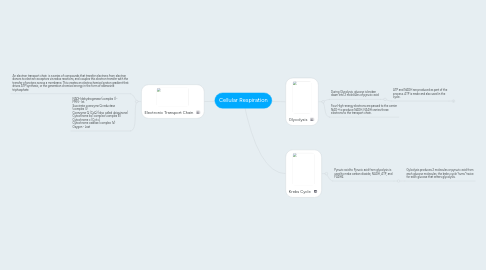Cellular Respiration
by Chelsea Stepp


1. Glycolysis
1.1. During Glycolysis, glucose is broken down into 2 molecules of pyruvic acid
1.1.1. ATP and NADH are produced as part of the process. ATP is made and also used in the cycle.
1.1.1.1. Four High-energy electrons are passed to the carrier NAD+ to produce NADH. NADH carries these electrons to the transport chain.
1.2. Four High-energy electrons are passed to the carrier NAD+ to produce NADH. NADH carries these electrons to the transport chain.
2. Krebs Cycle
2.1. Pyruvic acid to Pyruvic acid from glycolysis is used to make carbon dioxide, NADH, ATP, and FADH2.
2.1.1. Gylcolysis produces 2 molecules or pyruvic acid from each glucose molecules, the krebs cycle "turns" twice for each glucose that enters glycolysis.
